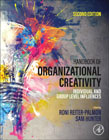
Handbook of Organizational Creativity: Individual and Group Level Influences
Reiter-Palmon, Roni
Hunter, Sam
In the last 20 years, research, theory and practice have focused on the need to improve creativity and innovation in organizations. In 2010, a survey of 1500 CEOs worldwide, conducted by IBM, listed creativity as one of the most important skills for managers and leaders of organizations. More recently, the World Economic Forum listed creativity, as well as related aspects such as critical thinking and complex problem solving, as the most important skills needed for the 21st century. This Second Edition of the Handbook updates coverage from recent research and adds topics not previously addressed including technology and creativity, artificial Intelligence work, a section on creativity within specific applied domains (e.g., engineering, science, therapy), and expands coverage of leadership to an entire section. The book includes individual, team, and organizational level factors, and includes organizational interventions to facilitate creativity (such as training) . The first volume on Individual and Group Level Processes introduces readers to the concepts of creativity in organizations. This will cover measurement and myths related to creativity, followed by individual and group influences on organizational creativity. Chapters focus on creative abilities and creative problem-solving processes, and individual difference variables such as motivation, affect, and personality. New chapters include the neuroscience of creativity, creativity and meaning, morality/ethicality and creativity, and creative self-beliefs. Group level phenomena will examine team cognition, team social processes, team diversity, social networks, and multi-team systems and creativity. Volume 2 on Leadership and macro influences on organizational creativity expands coverage of leadership to a full section. Coverage here includes different types and approaches to leadership such as transformational leadership, ambidextrous leadership leader-follower relations, and inclusive leadership. This is followed by organizational level influences such as organizational structure cultural and cross-cultural issues, and organizational factors influencing learning and change. A new chapter on gig and temporary workers is included here. A section on organizational interventions and field demands will include chapters examining, rewards, training, employee selection, performance management, and organizational development. New chapters here include Artificial Intelligence, technology, design thinking, and job requirements for creativity. The section on fields examines creative work in marketing, engineering, the arts, science, and medicine. Focuses on the key need to increase creativity and innovation in organizations Identifies the factors influencing organizational creativity Includes Individual, Group, and Organizational influences Specifies how these factors play out in specific subject domains Presents interventions to improve organizational creativity INDICE: Intro Section1. Introduction: Creativity in Organizations2. Methods and Measures in Organizational Creativity Research3. Blockages to Creativity4. Outcomes of Creativity5. Myths and urban legendsIndividual Section6. Expertise7. Creative Problem-Solving8. Creative Abilities: Divergent Thinking9. Idea Evaluation10. Affect11. Motivation12. Personality13. Creative self-beliefs14. Neuroscience15. Paradoxical thinking16. meaning and creativity17. Morality/ethicality and creativityGroups and Teams Section18. Team Cognition19. Group Processes20. Psychological Safety21. Virtual Teams22. Diversity and Cultures23. Networks24. Climate25. Nature of work26. Project Management27. Mult Team Systems28. Brainstorming29. Meetings
- ISBN: 978-0-323-91840-4
- Editorial: Academic Press
- Encuadernacion: Cartoné
- Páginas: 610
- Fecha Publicación: 01/06/2023
- Nº Volúmenes: 1
- Idioma: Inglés
